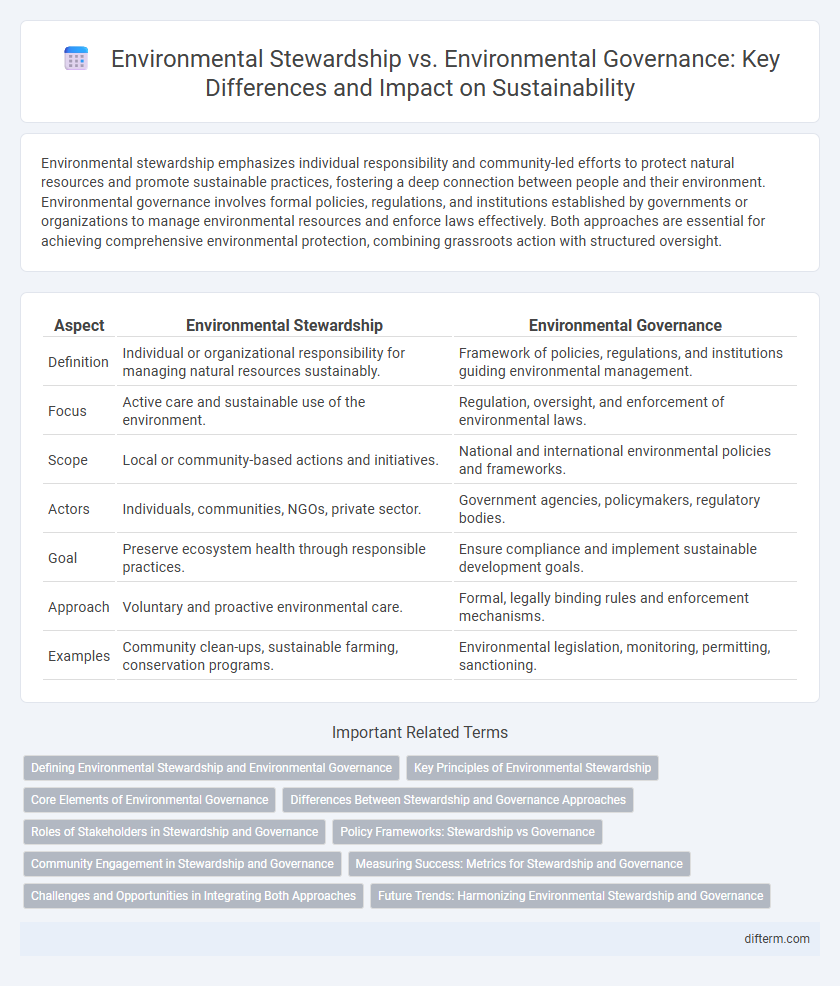Environmental stewardship emphasizes individual responsibility and community-led efforts to protect natural resources and promote sustainable practices, fostering a deep connection between people and their environment. Environmental governance involves formal policies, regulations, and institutions established by governments or organizations to manage environmental resources and enforce laws effectively. Both approaches are essential for achieving comprehensive environmental protection, combining grassroots action with structured oversight.
Table of Comparison
| Aspect | Environmental Stewardship | Environmental Governance |
|---|---|---|
| Definition | Individual or organizational responsibility for managing natural resources sustainably. | Framework of policies, regulations, and institutions guiding environmental management. |
| Focus | Active care and sustainable use of the environment. | Regulation, oversight, and enforcement of environmental laws. |
| Scope | Local or community-based actions and initiatives. | National and international environmental policies and frameworks. |
| Actors | Individuals, communities, NGOs, private sector. | Government agencies, policymakers, regulatory bodies. |
| Goal | Preserve ecosystem health through responsible practices. | Ensure compliance and implement sustainable development goals. |
| Approach | Voluntary and proactive environmental care. | Formal, legally binding rules and enforcement mechanisms. |
| Examples | Community clean-ups, sustainable farming, conservation programs. | Environmental legislation, monitoring, permitting, sanctioning. |
Defining Environmental Stewardship and Environmental Governance
Environmental stewardship involves the responsible management and care of natural resources through individual and community actions aimed at sustainability. Environmental governance encompasses the frameworks, policies, and institutions that regulate environmental protection and resource use at local, national, or global levels. Both concepts are essential for addressing ecological challenges, with stewardship emphasizing proactive engagement and governance focusing on regulatory oversight.
Key Principles of Environmental Stewardship
Environmental stewardship emphasizes responsible management and care for natural resources, prioritizing sustainability, conservation, and ethical use of ecosystems. Key principles include accountability, intergenerational equity, precautionary measures, and community involvement to ensure long-term environmental health. This approach fosters a collective commitment to preserving biodiversity and reducing ecological footprints beyond regulatory compliance.
Core Elements of Environmental Governance
Environmental governance encompasses the frameworks, policies, and institutions that regulate human interaction with the environment, emphasizing transparency, accountability, and participation from diverse stakeholders. Core elements include regulatory enforcement, inclusive decision-making processes, and adaptive management practices aimed at sustaining natural resources. Effective environmental stewardship relies on these governance principles to promote responsible resource use and long-term ecosystem health.
Differences Between Stewardship and Governance Approaches
Environmental stewardship emphasizes individual and community responsibility for managing natural resources sustainably, fostering local engagement and ethical care for ecosystems. Environmental governance involves formal institutional frameworks, policies, and regulations enforced by governments and international bodies to ensure compliance and coordinate large-scale environmental management. The key difference lies in stewardship's grassroots, voluntary actions versus governance's structured, authoritative oversight mechanisms.
Roles of Stakeholders in Stewardship and Governance
Environmental stewardship involves active participation from individuals, communities, and private sectors in sustainably managing natural resources, emphasizing responsibility and ethical commitment. Environmental governance encompasses formal policies, regulations, and institutional frameworks established by governments and international bodies to ensure compliance and coordinate collective action. Effective environmental outcomes depend on the collaboration between stakeholders in stewardship roles and governance institutions to align local initiatives with regulatory standards and global environmental goals.
Policy Frameworks: Stewardship vs Governance
Environmental stewardship emphasizes community-led initiatives and ethical responsibility to protect natural resources through sustainable practices, fostering local engagement and long-term conservation. Environmental governance involves formal policy frameworks, regulatory mechanisms, and institutional oversight to enforce environmental laws and coordinate multi-level stakeholder actions. Effective policy frameworks integrate stewardship principles with governance structures to create adaptive, accountable, and inclusive environmental management systems.
Community Engagement in Stewardship and Governance
Community engagement in environmental stewardship emphasizes local participation in conserving natural resources and promoting sustainable practices through education and hands-on initiatives. Environmental governance incorporates broader institutional frameworks that enable inclusive decision-making processes, policy implementation, and accountability mechanisms at regional and national levels. Effective collaboration between communities and governing bodies enhances transparency, fosters collective responsibility, and improves environmental outcomes.
Measuring Success: Metrics for Stewardship and Governance
Measuring success in environmental stewardship involves tracking tangible outcomes such as biodiversity indices, carbon sequestration rates, and community engagement levels, which reflect direct conservation efforts and sustainable resource use. Environmental governance success metrics, however, emphasize policy implementation effectiveness, regulatory compliance rates, and transparency in decision-making processes to ensure robust institutional frameworks. Combining these metrics provides a comprehensive assessment of both grassroots actions and top-down governance, enabling adaptive management for improved environmental outcomes.
Challenges and Opportunities in Integrating Both Approaches
Environmental stewardship emphasizes local community engagement and responsibility in managing natural resources, while environmental governance involves institutional frameworks and policy enforcement at broader scales. Challenges in integrating both approaches include balancing grassroots initiatives with regulatory compliance, addressing multi-level jurisdictional conflicts, and ensuring equitable stakeholder participation. Opportunities arise from combining localized knowledge with formal governance structures to create adaptive, inclusive, and effective environmental management strategies.
Future Trends: Harmonizing Environmental Stewardship and Governance
Future trends emphasize harmonizing environmental stewardship and governance to achieve sustainable resource management and climate resilience. Integrating community-led stewardship initiatives with robust policy frameworks enhances accountability and adaptive capacity in addressing environmental challenges. Advances in digital monitoring and data-sharing technologies support transparent governance while empowering local stakeholders to contribute to ecosystem preservation.
environmental stewardship vs environmental governance Infographic

 difterm.com
difterm.com